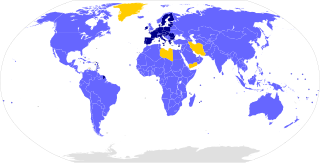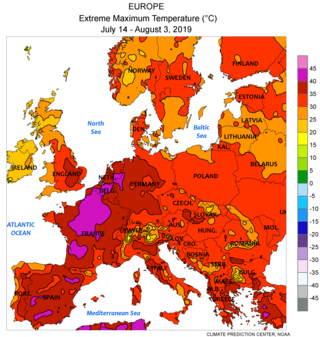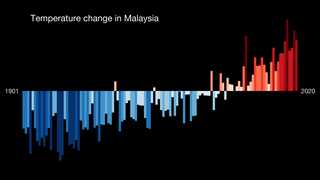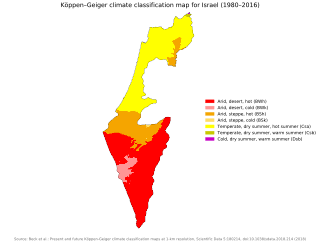The United Nations Framework Convention on Climate Change (UNFCCC) is the UN process for negotiating an agreement to limit dangerous climate change. It is an international treaty among countries to combat "dangerous human interference with the climate system". The main way to do this is limiting the increase in greenhouse gases in the atmosphere. It was signed in 1992 by 154 states at the United Nations Conference on Environment and Development (UNCED), informally known as the Earth Summit, held in Rio de Janeiro. The treaty entered into force on 21 March 1994. "UNFCCC" is also the name of the Secretariat charged with supporting the operation of the convention, with offices on the UN Campus in Bonn, Germany.
Climate Change 2007, the Fourth Assessment Report (AR4) of the United Nations Intergovernmental Panel on Climate Change (IPCC), was published in 2007 and is the fourth in a series of reports intended to assess scientific, technical and socio-economic information concerning climate change, its potential effects, and options for adaptation and mitigation. The report is the largest and most detailed summary of the climate change situation ever undertaken, produced by thousands of authors, editors, and reviewers from dozens of countries, citing over 6,000 peer-reviewed scientific studies. People from over 130 countries contributed to the IPCC Fourth Assessment Report, which took six years to produce. Contributors to AR4 included more than 2,500 scientific expert reviewers, more than 800 contributing authors, and more than 450 lead authors.

Climate change has been a critical issue in Australia since the beginning of the 21st century. Australia is becoming hotter and more prone to extreme heat, bushfires, droughts, floods, and longer fire seasons because of climate change. Climate issues include wildfires, heatwaves, cyclones, rising sea levels, and erosion.

Climate change has serious effects on Russia's climate, including average temperatures and precipitation, as well as permafrost melting, more frequent wildfires, flooding and heatwaves. Changes may affect inland flash floods, more frequent coastal flooding and increased erosion reduced snow cover and glacier melting, and may ultimately lead to species losses and changes in ecosystem functioning.

Climate change is having major effects on the Chinese economy, society and the environment. China is the largest emitter of carbon dioxide, through an energy infrastructure heavily focused on coal. Other industries, such as a burgeoning construction industry and industrial manufacturing, contribute heavily to carbon emissions. However, like other developing countries, on a per-capita basis, China's carbon emissions are considerably less than countries like the United States. It has also been noted that higher-income countries have outsourced emissions-intensive industries to China. On the basis of cumulative CO2 emissions measured from 1751 through to 2017, China is responsible for 13% globally and about half of the United States' cumulative emissions. China is now the world's largest polluter and in 2023 recorded it's hottest year on record with an average temperature of 10.7 C.

The Paris Agreement is an international treaty on climate change that was adopted in 2015. The treaty covers climate change mitigation, adaptation, and finance. The Paris Agreement was negotiated by 196 parties at the 2015 United Nations Climate Change Conference near Paris, France. As of February 2023, 195 members of the United Nations Framework Convention on Climate Change (UNFCCC) are parties to the agreement. Of the three UNFCCC member states which have not ratified the agreement, the only major emitter is Iran. The United States withdrew from the agreement in 2020, but rejoined in 2021.

Climate change has serious impacts on the water resources in Jordan. The country needs to prepare for the impacts of climate change. Water resources in Jordan are scarce. Besides the rapid population growth, the impacts of climate change are likely to further exacerbate the problem. Temperatures will increase and the total annual precipitation is likely to decrease, however with a fair share of uncertainty. Hence, existing and new activities with the objective to minimize the gap between water supply and demand contribute to adapt Jordan to tomorrow's climate. This might be accompanied by activities improving Jordan's capacity to monitor and project meteorological and hydrological data and assess its own vulnerability to climate change.

Belgium has the 7th largest CO2 emission per capita in the EU. The CO2 emissions have dropped 19.0% since in comparison with 1990 levels. The average temperature has risen 1.9 degrees Celsius since measurements began in 1890, with an acceleration since 1954.
Climate change in Luxembourg discusses the climate change issues in Luxembourg. Luxembourg is a territory of 998.4 miles. Of the total area of Luxembourg, 85.5% was agricultural land and land under forest – with around 51% for agriculture and 35% for forests. Changes in temperature and rainfall will have an impact on Luxembourg especially due to their high percentage of forestry.

The nationally determined contributions (NDCs) are commitments that countries make to reduce their greenhouse gas emissions as part of climate change mitigation. These commitments include the necessary policies and measures for achieving the global targets set out in the Paris Agreement. The Paris Agreement has a long-term temperature goal which is to keep the rise in global surface temperature to well below 2 °C (3.6 °F) above pre-industrial levels. The treaty also states that preferably the limit of the increase should only be 1.5 °C (2.7 °F). To achieve this temperature goal, greenhouse gas emissions should be reduced as soon as, and by as much as, possible. To stay below 1.5 °C of global warming, emissions need to be cut by roughly 50% by 2030. This figure takes into account each country's documented pledges or NDCs.

Climate change is having a considerable impact in Malaysia. Increasing temperatures are likely to greatly increase the number of heatwaves occurring annually. Variations in precipitation may increase the frequency of droughts and floods in various local areas. Sea level rise may inundate some coastal areas. These impacts are expected to have numerous environmental and socioeconomic effects, exacerbating existing environmental issues and reinforcing inequality.

Climate change in Algeria has wide-reaching effects on the country. Algeria was not a significant contributor to climate change, but, like other countries in the Middle East and North Africa (MENA) region, is expected to be among the most affected by climate change impacts. Because a large part of the country is in already hot and arid geographies, including part of the Sahara, already strong heat and water resource access challenges are expected to get worse. As early as 2014, scientists were attributing extreme heat waves to climate change in Algeria. Algeria was ranked 46th of countries in the 2020 Climate Change Performance Index.

Climate change in Ghana is impacting the people in Ghana in several ways as the country sits at the intersection of three hydro-climatic zones. Changes in rainfall, weather conditions and sea-level rise will affect the salinity of coastal waters. This is expected to negatively affect both farming and fisheries.

Climate change in Senegal will have wide reaching impacts on many aspects of life in Senegal. Climate change will cause an increase in average temperatures over west Africa by between 1.5 and 4 °C by mid-century, relative to 1986–2005. Projections of rainfall indicate an overall decrease in rainfall and an increase in intense mega-storm events over the Sahel. The sea level is expected to rise faster in West Africa than the global average. Although Senegal is currently not a major contributor to global greenhouse gas emissions, it is one of the countries most vulnerable to climate change.

Climate change has had serious consequences in Azerbaijan since the start of the 21st century. The climate of Azerbaijan was 1.3 degrees hotter by 2010. The Caspian Sea is shrinking. Azerbaijan will host the 2024 United Nations Climate Change Conference, known as COP29.
The climate of Greece is changing by way of increased drought, flooding, wildfires and sea level rise. These extreme weather conditions are likely to become more frequent and as a result landscapes and biodiversity will be affected. Climate change will also cause human activities such as land-use change, urbanisation and soil degradation to further affect Greek's ecosystems. Ecosystems in Greece are already at their tipping point, close to their environmental limits. Policies and laws have been put in place by the Greek government to try to manage these issues.

Climate change in the Middle East and North Africa (MENA) refers to changes in the climate of the MENA region and the subsequent response, adaption and mitigation strategies of countries in the region. In 2018, the MENA region emitted 3.2 billion tonnes of carbon dioxide and produced 8.7% of global greenhouse gas emissions (GHG) despite making up only 6% of the global population. These emissions are mostly from the energy sector, an integral component of many Middle Eastern and North African economies due to the extensive oil and natural gas reserves that are found within the region. The region of Middle East is one of the most vulnerable to climate change. The impacts include increase in drought conditions, aridity, heatwaves and sea level rise.

Climate change in South Africa is leading to increased temperatures and rainfall variability. Evidence shows that extreme weather events are becoming more prominent due to climate change. This is a critical concern for South Africans as climate change will affect the overall status and wellbeing of the country, for example with regards to water resources. Just like many other parts of the world, climate research showed that the real challenge in South Africa was more related to environmental issues rather than developmental ones. The most severe effect will be targeting the water supply, which has huge effects on the agriculture sector. Speedy environmental changes are resulting in clear effects on the community and environmental level in different ways and aspects, starting with air quality, to temperature and weather patterns, reaching out to food security and disease burden.

Israel, like many other countries in the Middle East and North Africa, experience adverse effects from climate change. Annual and mean temperatures are increasing in Israel, with mean temperature expected to increase between 1.6 and 1.8 °C by 2100. There is a reduction in annual precipitation and delayed winter rains. Israel is already experiencing droughts and water shortages. Heatwaves are other natural hazards expected to increase with climate change.
Climate change in Uruguay describes the effects of climate change in Uruguay. As the result of global temperature increases, Uruguay is expected to have temperature increases of 3 °C by about 2100 and there is expected increases in precipitation. Increases of climate rain in Uruguay and Argentina during 2018 was estimated by the World Meteorological organization to have caused $2.5 billion in damage.
















